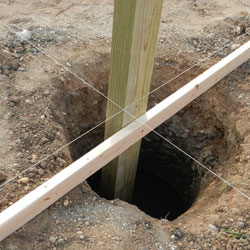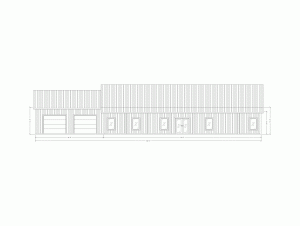This is construction, things happen. The true mark of how any particular project goes is not everything going perfectly without a hitch, it is the ability to solve challenges when they arise.
The scenario below is one which I have never had a DIY person do (shout out to all of you who are putting up your own buildings), only “contractors” who somehow neglected to read this particular portion of the building plans (portion being used liberally as the column sizes are only called out on five different pages of the engineer sealed plans).
 From the client:
From the client:
“I realized last night that the crew who installed my posts placed the posts in the wrong locations and they are now cemented in. Instead of using the laminated posts in the center section they put them on the ends of the building. That means the solid posts are in the center section. I need to know if/how this will affect my building? Thanks.”
And my response:
Thank you for utilizing the Hansen Pole Buildings’ Technical Support system. It appears you have some challenges to resolve. As the columns are now installed, the ones on the sidewalls, where the glu-laminated columns were supposed to be, will be over-stressed and will not support the wind loads adequately. There are some options:
(a) Dig the columns out, chip the concrete off of them and replace them where they belong. This involves more work than the later options, but will not require an investment into more columns.
(b) Dig out only the six errantly placed 6×6 columns, order six new glu-laminated columns to replace them. Less work, however there will be the cost of the six columns.
Either of the above choices (a) or (b) will involve properly compacting the soil into which the corrected columns will be replaced.
(c) This fix is subject to approval from the engineer of record and would have a nominal fee for him to author and seal a letter to confirm the adequacy. Place a 2x10x14′ #2 Pressure Preservative treated to UC-4B on each of the sides towards the endwalls of the six offending 6×6 columns – starting at the top of the concrete bottom collar. 2x10s to be attached with 2-10d common hot dipped galvanized nails, spaced every six inches and staggered to avoid splitting. There is approximately a five week lead time to get the 2×10 treated, as it would be by special order – there are not lumberyards (or big box stores) which have this material in inventory.
Constructing a new post frame building? Whether a DIYer or a veteran contractor, please follow the adage of: “Look at the plans twice, so materials only have to be installed once!”
 These are very simple drawings which don’t really tell you how to build anything. In fact, once you get your plans, you may not take more than a quick glance at the elevation drawings, other than to be sure the building looks exactly the way you envision it. This includes where the doors and windows have been drawn. This is what counties like to see in deciding if the proposed new building is going to meet very specific guidelines in the area of aesthetics. Basically, does it “fit in” within the neighborhood, or is it going to stick out like a sore thumb? The community’s governing body decides what is “ok” or “not ok” for you to build.
These are very simple drawings which don’t really tell you how to build anything. In fact, once you get your plans, you may not take more than a quick glance at the elevation drawings, other than to be sure the building looks exactly the way you envision it. This includes where the doors and windows have been drawn. This is what counties like to see in deciding if the proposed new building is going to meet very specific guidelines in the area of aesthetics. Basically, does it “fit in” within the neighborhood, or is it going to stick out like a sore thumb? The community’s governing body decides what is “ok” or “not ok” for you to build.





